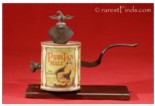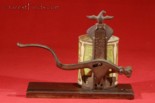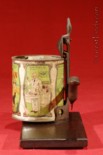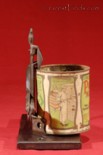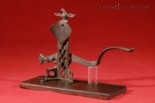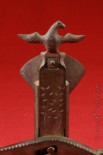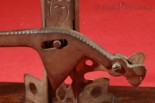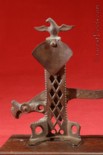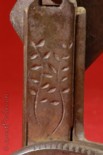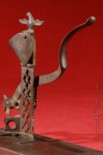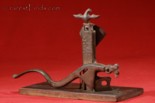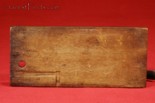Exceedingly Rare Williams Can Opener, Patented On January 8th, 1878. Sold!
Patents, click on any image to see larger image!



This exceedingly rare can-opener made of cast iron is screwed to a Walnut board with two screws. Most likely this is the only surviving can-opener of its kind.
The casting is very delicate and with certainty the reason why this seems to be the only extant and 100% intact can-opener of its kind. The main frame of the can-opener is decorated with diamond shaped openings which are very decorative but unfortunately weakened the frame to the point where it was prone to break if under pressure, or if it was dropped to the floor.
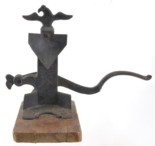
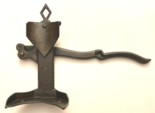 This can-opener was patented on January 8th 1878, and is the invention of Charles M. Williams of Bethel, Kentucky, United States.
This can-opener was patented on January 8th 1878, and is the invention of Charles M. Williams of Bethel, Kentucky, United States.
There are two other, later versions, known, both without the open framework in the casting. The casting first was changed by removing the 13 diamond-shaped and the two round openings to make the frame stronger, so it would not break so easily. The eagle remained on this second model shown on the left. This later model still had the second cutting blade for small cans on the back side.
The third model shown on the right has just one diamond shaped ornament on top of the can-opener which replaces the eagle on the first two models. The second blade in the back is no longer present on this third model. This particular can-opener model 3 was in the collection of Joe & Jackie Young in Elgin, IL, USA.
The decor of the cast iron on the first and second model is typical for the time and is called spoon carving in the Eastlake style.
If an operator would have used too much force operating this delicate machine offered here, the cast iron frame would or could break. Or consider this; if anybody over the last 140 years would have dropped it once, the eagle would have lost his wings or worse.
This is a very decorative piece of art and it is a miracle that it survived the last 140 plus years.
The Walnut board measures app. 11 by 5 inches, the top of the eagle is 7½ inches above the board.
Condition:
There is nothing broken, missing, repaired, or in any other way less than perfect on this can-opener!
History:
The Williams can opener is obviously the first can-opener with the patented mechanism. The hand-held can-opener with a leveraged knife was around as early as April 1840, when John Gillion & Co. of Edinburgh, Scotland started canning vegetables and other food.
Click here, to read an article on the subject I found on the internet.
Eastlake style is technically considered Victorian; being popular from 1870 to 1890, it breaks away from the excessive high-relief carving, classical elements, and numerous curves of other styles produced during this time frame. Lines are simple and rooted in nature, but geometric design elements were also very common.
Charles Locke Eastlake (1836 - 1906) was a British architect and furniture designer. In 1868 he published, “Hints on Household Taste in Furniture, Upholstery and other Details”, which was very influential in Britain, and in the United States, where the book was published in 1872. From 1866 to 1877 he was secretary to the Royal Institute of British Architects, and from 1878 to 1898 he was Keeper of the National Gallery, London.
Inventory Number 09340;
Sold!
